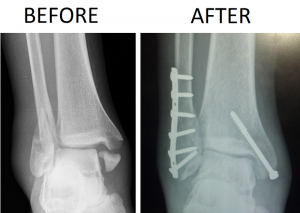A Quick Word on Derek Jeter’s Ankle Injury

On Saturday, October 13, 2012, Derek Jeter broke his left ankle during game one of the ALCS. As he fell earthward, so did the hopes of the Yankees and their fans. After numerous test and examination from a number of well reputed doctors, Jeter announced he was going to need surgery. Jeter’s surgery and rehab were successful; it was announced at that time that he would be ready to go for the season opener. So Jeet comes back in March and everyone is happy. For a day. Jeter is currently out again after playing in one measly game because his ankle is “cranky.” However, he has an x-ray and MRI, which reveals “inflammation,” an ominous word leaving fans to be a little concerned. The question is: should they be?
In a word: yes. To understand why, first lets take a look at what happened initially.
I truly cannot comment on the details of Jeter’s injury, as this information was never released. What we do know is that Jeter’s fracture was significant enough to require surgery. This probably means that he had what is called a “bimalleolar” fracture. The malleoli are what people often call their “ankle bones” that protrude medially (inside) and laterally (outside) from the ankle (there’s sort of a third malleoli, but we won’t worry about that right now).
When someone fractures one of the malleoli, they can often get away without surgery (as originally thought with Jeter) but when both or all three fracture, surgery is required. This extends the typical rehab by about 6-8 weeks and provides more opportunity for crap to happen down the road. The surgery, called an Open (surgically open) Reduction (set the bones in place) Internal (inside the body) Fixation (held together by hardware) is performed and rehab is initiated.
The problem is that while the hardware holds everything together, it can become irritated for some people, giving them prolonged symptoms that eventually require its removal. For Jeter, we are also unsure of any soft tissue damage that may have occurred to the ligaments, cartilage, or tendons in the region. From what we’ve been hearing, it would appear that the fracture is the primary issue. At any rate, today we see that Jeter’s ankle is still not responding perfectly to getting back to play. What gives?
There are a few things to consider. Its funny that Joe Girardi used the word “cranky” because its a word many physical therapists use to describe a joint that becomes irritated for whatever reason during rehab. I use the term all the time and it is a normal part of the process. Any time someone reaches a new level in function, the joint often gets cranky. It represents a small amount of irritation or inflammation in the tissues affected by the injury. In addition, anyone who has has a significant orthopedic surgery will tell you that the joint often gets pissed off for any number of silly reasons for the first year or so (and beyond). Things like weather changes, or getting dehydrated (ie, hungover) can do it. It’s not a huge deal.
So why am I a little worried about Jeter? Two primary reasons. First, when a patient tells me that their joint is cranky, we don’t run and do an MRI. It takes significant or prolonged signs and symptoms to make us do this. So, I am a little concerned that the Yankees medical staff ran out and ordered imaging right away. Jeter doesn’t seem like the type to bitch a lot, so he must have said something that raised a flag for someone. If this was July, I’d say fine. But now? I’m not at ease. Secondly, the MRI revealed mild inflammation. Now I know “mild” sounds reassuring but that title is misleading. When inflammation actually is visible on an MRI, it is usually associated with more troublesome symptoms. With truly mild symptoms and mild inflammation, the MRI signal does not change enough to pick it up; everything just looks gray. In this case, the signal intensity was increased, meaning something came up white on the MRI. This is usually indicative of something a little more annoying.
I’m not saying Jeter is done or going to miss a huge chunk of time. As Wallace Matthews pointed out:
@afr_sports could be they were just playing it safe. Pro teams MRI jock itch. they can afford it
— wallace matthews (@ESPNNYYankees) March 20, 2013
He’s right in that with the face of Major League Baseball, they’ll MRI at the drop of a hat. Jimmy the plumber has to wait. Plus, Jeet’s a tough cat, as we all know. But be aware, Yankees fans, that his injury is probably going to haunt Jeter all year. Get ready for some games off and DHing for him in the near future. I think he’ll be ok, but that’s it. Just ok.
UPDATE: So here we are on opening day and, for the first time in 12 years and only the second in 18, there will be no Derek Jeter. He will be retroactively placed on the DL, making him available on April 6. If he’s ready, of course. The MLB.com reports that the Yankees will not play Jeter unless he can play 9 innings of shortstop on consecutive days. The most he’s gotten so far is 5 innings. This is a major bummer, but if Jeet comes back too fast he’ll only prolong the setback. Let’s hope the healing process continues well and he’ll be on the field soon. Unfortunately, there are no guarantees as to when that will be or how long it will last.
These flareups are common when there is a major functional progression in rehab (any of you who has had an orthopedic surgery of any kind knows this). Derek Jeter is no different. His ankle will settle down soon enough and he’ll be back out there. But he’ll have to be very carefully managed throughout the season to ensure that he won’t be feeling too banged up during the home stretch. If the Yanks make it to October, they’ll need the Captain at full strength.
Share Tweet



